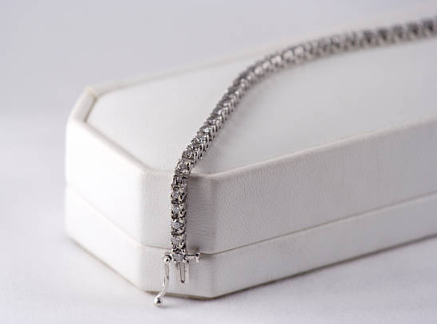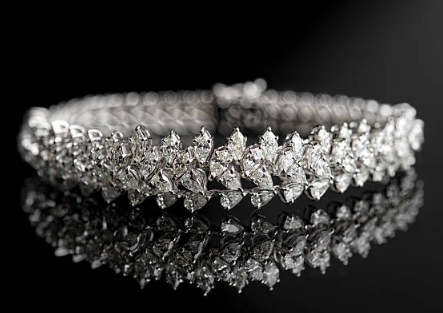A tennis bracelet is a piece of jewelry made from many small diamonds that are mounted in tiny metal settings and joined together. Here are some tips on how to evaluate the most important features of a tennis bracelet when buying a tennis bracelet.
The Diamond Color of the Tennis Bracelet
In general, the whiter the diamond in the bracelet, the higher the quality of its color (unless the gemstone is a fancy colored diamond). However, this quality comes at a price, and you should be prepared to pay more for a tennis bracelet set with almost colorless diamonds than for a tennis bracelet set with a distinctly yellowish diamond.

Metals are important.Your bracelet doesn’t always need to come with a top-color diamond, though.
For example, if you are going to buy a yellow gold tennis bracelet, you can choose a gemstone with a slight yellow tint: it will become less noticeable with the yellow finance, thus making the white in the diamond stand out.
However, if you buy a white bracelet, such as a white gold bracelet, make sure that the diamond looks almost colorless, as any yellow hues in it will stand out against the white background.
Uniformity is important. Regardless of the exact grade of your diamond’s color, it is more important that all gemstones are the same color. You don’t want a tennis bracelet that looks like a patchwork of randomly arranged white and pale yellow diamonds.
Diamond Clarity and Tennis Bracelet
When it comes to tennis bracelets, clarity isn’t as important as color, for one simple reason: the diamonds in these pieces are too small for most of the imperfections to be seen with the naked eye unless you look at them from a very close distance.
Size is important for clarity. However, you should keep in mind that the larger the diamond, the more important the clarity becomes. Inclusions are more pronounced in larger diamonds, so when choosing a tennis bracelet with a larger diamond, make sure they don’t have imperfections that are easily visible to the naked eye.

Inspect the diamond for damage. Look closely at the gemstone, preferably using a jeweler’s magnifying glass, and check the gemstone for chips and cracks. You don’t want to buy a bracelet with a damaged diamond – once the integrity of the diamond is compromised, they are more likely to break further.
The Structure of a Tennis Bracelet
In general, the structure of a tennis bracelet should be strong enough to ensure a safe fit and protect it from bumps, blows, bumps, etc.
Diamond setting: Check how a single diamond is set in the bracelet. They should be set up in such a way that the stone does not fall off easily and provide some protection against collisions.
For example, a bezel setting is the safest of the two – the diamond is held in place by a metal band that completely or partially surrounds the diamond. The setting of each gemstone with four claws in place is also a good choice.
Chain links: Look at the links of a tennis bracelet – they should be strong and not easily break when the bracelet is pulled hard.
Snaps: Test the snaps to make sure they close securely and are not easy to open. It should be sturdy and not easily bend or break.
Flexibility: A tennis bracelet is best to have flexibility because if it is too hard, it will break easily whenever you twist it (as often happens when wearing such items).
To test the flexibility of the bracelet, hang it up and see if it hangs straight in the air without kinks.

Choose the Metal of the Bracelet
When deciding on the metal material of your tennis bracelet, you should keep in mind that there is a trade-off between durability and price.
For example, gold and silver are softer and wear out faster. However, if you don’t plan on wearing bracelets every day, they are a good and affordable option.
More durable alternatives, such as platinum, are more expensive but allow you to wear your tennis bracelet more often without worrying about its parts wearing out and breaking quickly.
White gold is a good intermediate choice because it is more durable than gold, but not as expensive as platinum.
